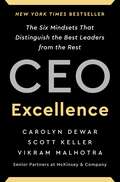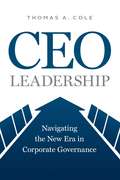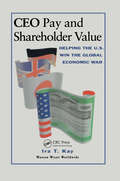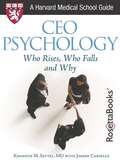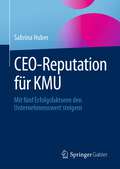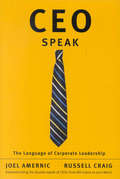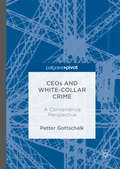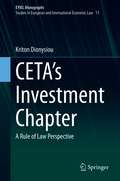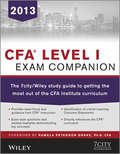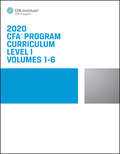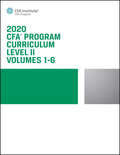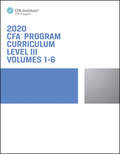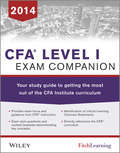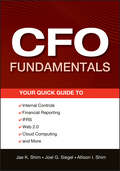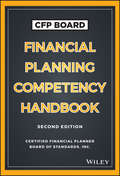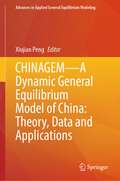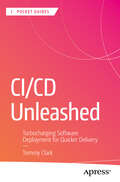- Table View
- List View
CEO Excellence: The Six Mindsets That Distinguish the Best Leaders from the Rest
by Scott Keller Carolyn Dewar Vikram MalhotraNew?York?Times Bestseller • Wall?Street?Journal Bestseller From McKinsey & Company, the world&’s most influential management consulting firm, comes CEO Excellence, an insight-packed leadership book that reveals how the best CEOs think and act—based on interviews with elite leaders from Netflix, JPMorgan Chase, General Motors, Sony, and more.Being a CEO at a major company is one of the toughest executive roles—Fortune?500 CEOs often face massive stakes, yet many fail early: 30% don&’t last three years, and 40% are deemed ineffective within eighteen months. What separates successful CEOs from the rest? The authors began with over 2,400 public-company CEOs, narrowed to an elite sixty-seven who participated in multi-hour interviews. Among them: Jamie Dimon (JPMorgan Chase), Satya Nadella (Microsoft), Reed Hastings (Netflix), Kazuo Hirai (Sony), Ken Chenault (American Express), Mary Barra (GM), Peter Brabeck-Letmathe (Nestlé), and others—offering rich insight into CEO best practices, leadership strategy, and business execution. Their candid conversations and McKinsey&’s data reveal how the top CEOs use core mindsets and signature practices—across strategy, culture, talent, stakeholder engagement, board relations, and personal effectiveness—to deliver extraordinary results. Practical, unprecedented in scope, and essential for leaders at every level, CEO Excellence is a management manual grounded in real-world CEO experience and leadership innovation.
CEO Leadership: Navigating the New Era in Corporate Governance
by Thomas A. ColeCorporate governance for public companies in the United States today is a fragile balance between shareholders, board members, and CEOs. Shareholders, who are focused on profits, put pressure on boards, who are accountable for operations and profitability. Boards, in turn, pressure CEOs, who must answer to the board while building their own larger vision and strategy for the future of the company. In order for this structure to be successful in the long term, it is imperative that boards and CEOs come to understand each other’s roles and how best to work together. Drawing on four decades of experience advising boards and CEOs on how to do just that, Thomas A. Cole offers in CEO Leadership a straightforward and accessible guide to navigating corporate governance today. He explores the recurring question of whose benefit a corporation should be governed for, along with related matters of corporate social responsibility, and he explains the role of laws, market forces, and politics and their influence on the governance of public companies. For corporate directors, he provides a comprehensive examination of the roles, responsibilities, and accountability the role entails, while also offering guidance on how to be as effective as possible in addressing both routine corporate matters and special situations such as mergers and acquisitions, succession, and corporate crises. In addition, he offers practical suggestions for CEOs on leadership and their interactions with boards and shareholders. Cole also mounts a compelling case that a corporate culture that celebrates diversity and inclusion and has zero tolerance for sexual misconduct is critical to long-term business success. Filled with vignettes from Cole’s many years of experience in the board room and C-suite, CEO Leadership is an invaluable resource for current and prospective directors, CEOs, and other senior officers of public companies as well as the next generation of corporate leaders and their business and financial advisors.
CEO Pay and Shareholder Value: Helping the U.S. Win the Global Economic War
by Ira T. KayU.S. executive pay, particularly that of CEOs, has been under serious attack for nearly a decade. Despite the fact that tying executive performance and pay to stock price has appeared to have substantially benefited the U.S. economy, this criticism has not subsided. CEO Pay and Shareholder Value challenges some assumptions behind this criticism by addressing these pertinent questions and more:
CEO Psychology: Who Rises, Who Falls, and Why (Harvard Medical School Guide)
by Joseph Cardillo Kenneth M. SettelHow do you tap into your skills and talents to lead successfully and take your organization to the next level? Informing you with the psychological understandings that create great leaders, you will use CEO Psychology to carve a path through the irrational behavior of people in organizations. You will learn to make sense of and harness your own talents and skills and those of the people who work for you. Become a more capable leader through learning to: Know yourself....your personal leadership profile Lead through engagement Work with change Manage emotional needs in the workplace Channel aggression constructively Manage conflict in the workplace Hire, promote and fire more successfully Envision your career trajectory CEO Psychology offers effective guidance that will inform leaders and help them navigate a course to success through the uncertainty and challenges of the business world. ABOUT THE AUTHOR Kenneth M. Settel, MD is a Clinical Instructor in Psychiatry at Harvard Medical School, where he teaches a course on Organizational Consultation to senior residents in Psychiatry. He is a principal in The Boswell Group, consulting to CEO's, their Organizations and Boards of Directors, to family businesses and to professional service organizations around issues of leadership, organizational development and conflict resolution. Over the past thirty-five years, he has written and given talks to the business community, to the psychiatric and to the psychoanalytic community about organizational function and leadership. He has a clinical and business consultation practice based in Brookline Massachusetts. Joseph Cardillo is a top-selling author in the fields of health, mind-body-spirit, and psychology. His books, The Five Seasons: Tap Into Nature's Secrets For Health, Happiness, and Harmony (New Page, June, 2013); Your Playlist Can Change Your Life (Sourcebooks, 2012); Can I Have Your Attention? How to Think Fast, Find Your Focus, and Sharpen Your Concentration (Career, 2010); Bow to Life (Perseus, 2006) and Be Like Water (Grand Central, 2003) have inspired people of all ages worldwide.
CEO School
by Stanislav Shekshnia Kirill Kravchenko Elin WilliamsThis book focuses on what makes a successful CEO and the paths to becoming one in today’s global economy. Chapters in the book include insights by 20 top CEOs – one from each G20 country – gathered from an extensive global qualitative research project. Through seven easy-to-digest “master classes” that demystify the role of the 21st century CEO, the authors present their findings in an accessible, conversational style that serves as a step-by-step guide for those who aspire to become CEOs, and develop essential character traits, experience, and skills required of the role.
CEO Succession at Cisco (A): From John Chambers to Chuck Robbins
by Boris Groysberg Annelena Lobb J. Yo-Jud ChengA smooth transition from former CEO John Chambers to new CEO Chuck Robbins had put Cisco in a position of strength. Looking back, the board reflected on what they had done well and what they might have done differently, and pondered whether another company might be able to implement a similar CEO transition process. This case reviews the specific steps taken by the board of directors and other stakeholders during the selection process. Participants in the process included John Chambers, who was the company's CEO at the time, the Cisco board of directors, Cisco's human resources group, and the executive search firm Spencer Stuart. The process occurred in several stages, including an informal stage during which the board became familiar with candidates, followed by a 16-month formal process with goal-setting and clear definition of roles for all involved, various interactions with and evaluations of possible candidates, and voting.
CEO Succession at Cisco (B): Announcement Strategy
by Boris Groysberg Annelena Lobb J. Yo-Jud ChengSupplements the (A) case (417-031). This case supplement describes Cisco's communications strategy around the CEO announcement, which focused on controlling the narrative and avoiding leaks. The strategy included both internal and external processes aimed at introducing the new CEO to employees and the general public, respectively. Externally, the process unfolded without media leaks and with a modest stock market reaction.
CEO Succession at Cisco (C): Chuck Robbins' First 100 Days
by Boris Groysberg Annelena Lobb J. Yo-Jud ChengSupplements the (A) case (417-031). This case supplement describes new CEO Chuck Robbins' earliest days after being announced as Cisco's new chief executive. During this time, Robbins focused on building a leadership team featuring people with complementary skills and the disclosure of top executive departures during the transition period. Chambers also assumed his new role as executive chairman during this time frame.
CEO of Earth
by Simon HammondHow, given the chance, would you market planet Earth as the ultimate tourist destination?Fysh Reynolds, 25-year-old MBA grad and internet superstar, must answer this question when his part-time job playing Ronald McDonald at kids' birthday parties thrusts him into an unexpected position of power.When aliens land on Earth, they mistake the golden arches to be our most prolific centre of authority and assume Fysh -- dressed as Ronald -- to be leader of the free world. The aliens' mission: to establish Earth as a premium travel destination for intergalactic tourists.Fysh, a gen Y marketing prodigy, is charged with creating the most powerful brand in the universe: Brand Earth. This fun, quirky and irreverent business fable unravels the mystery of why some brands have the power to inspire deep and primal emotions in consumers that make products legendary and their developers filthy rich. CEO of Earth is a blueprint for marketers who want to engage the philosophies that have propelled the world's most celebrated brands to greatness.
CEO-Reputation für KMU: Mit fünf Erfolgsfaktoren den Unternehmenswert steigern
by Sabrina HuberDieses Buch zeigt, wie die CEO-Reputation als strategischer Faktor in kleinen und mittelgroßen Unternehmen gezielt gemanagt werden kann. Denn CEOs sind die ersten und obersten Botschafter:innen eines Unternehmens und ihr Verhalten beeinflusst die Reputation wesentlich. Mit ihrer Persönlichkeit, ihrer Kommunikation und ihrem Auftritt repräsentieren CEOs das Unternehmen nach innen und außen – bewusst und unbewusst. CEO-Branding sollte daher nicht als zufälliger Nebeneffekt betrachtet werden, sondern als entscheidender strategischer Hebel. Die Autorin hat fünf Erfolgsfaktoren und eine Formel für erfolgreiches CEO-Branding entwickelt und in der Praxis vielfach erprobt: Strategie, Persönlichkeit, Kongruenz, Botschaft und Konzept. Auf Basis dieser Faktoren lässt sich ein strukturiertes, zielführendes und messbares CEO-Branding entwickeln, das Unternehmen einen nachhaltigen Wettbewerbsvorteil bringt. Außerdem: Experteninterviews zeigen auf, wie das Thema in der Praxis angegangen werden muss.
CEO-Speak
by Joel Amernic Russell CraigCEO-Speak explores the metaphors and persuasive strategies used by leaders at Enron, Microsoft, AOL-TimeWarner, General Electric, IBM, Nortel, Canadian National Railways, Andersen, Disney, and Alcan-Pechiney-Alusuisse. Amernic and Craig show that CEOs are frequently presented as heroes engaged in "the war of business" who can effect astonishing miracles of financial performance and reinvention. Contesting the notion that accounting is objective, CEO-Speak serves as an introduction to the controversies and ambiguities in corporate accountability and provides rich examples of the excesses of corporate communication.
CEO-Speak: The Language of Corporate Leadership
by Joel Amernic Russell CraigCEO-Speak explores the metaphors and persuasive strategies used by leaders at Enron, Microsoft, AOL-TimeWarner, General Electric, IBM, Nortel, Canadian National Railways, Andersen, Disney, and Alcan-Pechiney-Alusuisse. Amernic and Craig show that CEOs are frequently presented as heroes engaged in "the war of business" who can effect astonishing miracles of financial performance and reinvention. Contesting the notion that accounting is objective, CEO-Speak serves as an introduction to the controversies and ambiguities in corporate accountability and provides rich examples of the excesses of corporate communication.
CEOs and White-Collar Crime: A Convenience Perspective
by Petter GottschalkThis book aims to bridge the gap between general CEO research, which is traditionally focused on positive aspects of leadership, and lesser understood research into CEO misconduct and crime. Gottschalk introduces convenience theory as an integrated explanation for CEO involvement in white-collar crime. The chief executive officer is a unique position within an organization in terms of power and influence, role and behavior, compensation and benefits, and conflict and competition. The convenience perspective suggests that motivation (personal and organizational goals), opportunity (offense and concealment in an organizational context), as well as behavior (lack of control and neutralization of guilt) make financial crime a convenient option to avoid threats and to exploit opportunities. A thorough and methodical study, this book will be of special interest to scholars of corporate social responsibility and criminological theory.
CETA's Investment Chapter: A Rule of Law Perspective (European Yearbook of International Economic Law #13)
by Kriton DionysiouThis book provides a comprehensive account of the CETA Investment Chapter’s ability to overcome the legitimacy crisis facing investment arbitration. To do so, it first examines the root causes behind the legitimacy crisis, ultimately arguing that it reflects a fundamental rule of law crisis within investment arbitration. In particular, it asserts that the normative standpoints of the legitimacy crisis form part of the rule of law, the uniting legal principle from which the legitimacy concerns stem. The book contends that the rule of law is not only the principal normative and causal assumption on which the legitimacy concerns are based, but that it could also be utilized as a platform to evaluate the investment arbitration mechanism in CETA's Investment Chapter.Based on this, the book evaluates CETA's Investment Chapter through the rule of law framework in order to provide a convincing account of the latter's ability to overcome the legitimacy crisis facing investment arbitration. It concludes that CETA's Investment Chapter is unlikely to completely solve the legitimacy crisis simply because it is just a patchwork of reforms rather than a comprehensive reinvention of the substantive and procedural law of investment arbitration. Lastly, the book offers meaningful insights into the way the challenges presented by investment arbitration should be addressed. The book is intended for academics researching international investment law and arbitration as well as for policy-makers focusing on reforming investor-state dispute settlement.
CF MotorFreight in 1992
by David B. Yoffie Sheila CavanaughIn June 1992, CFMF management finds that despite a number-two ranking nationwide among long-haul carriers, two smaller rivals are far more profitable for the year-ended 1991. Management confronts the issue of encroaching competition from the country's smaller regional and niche carriers. CFMF management is faced with a unionized labor force and a transcontinental network of consolidation centers in an industry moving toward non-union labor and regional networks connected by rail.
CFA Level I Exam Companion
by 7city LearningProviding exam focus and knowledge application makes the CFA Level I Exam Companion the most effective study guide on the market.With a foreword and introductions to the topics by one of the foremost global authorities on the CFA Program, Pamela Drake, Wiley and 7city offer an invaluable self-study guide to passing one of the most sought-after designations in the finance industry. The CFA Level I Exam Companion assists candidates to navigate through the wealth of CFA Level I content, prioritizing key areas of the official CFA texts. The Exam Companion has been written by 7city's experienced CFA instructor faculty, who know what it takes to pass.This important supplement provides:Exam focus and guidance from 7city CFA instructorsExam style questions and worked examples demonstrating key conceptsIdentification of critical Learning Outcome StatementsDirect references to the CFA Institute curriculumBoth the print and the e-book form part of the Exam Companion study suite that includes:CFA Level I: Study Session Apps by 7city and Wiley (iOS, Android)CFA Level I: Are You Ready? App by 7city and Wiley (iOS, Android)7city CFA Course and Online Study OptionsThere is no substitute for genuine experience. With a reputation for enthusiasm, professionalism and innovation, 7city Learning prepares more than 3,000 people a year globally for the CFA exams. With a comprehensive online portal, exam prep tablet, virtual or live classroom sessions, question banks and extensive study materials; 7city make sure you have everything you need to best prepare yourself for the CFA Level I Exam.
CFA Program Curriculum 2020 Level I Volumes 1-6 Box Set (CFA Curriculum 2020)
by CFA InstituteClear, concise instruction for all CFA Program Level I concepts and competencies for the 2020 exam The same official curricula that CFA Program candidates receive with program registration is now publicly available for purchase. CFA Program Curriculum 2020 Level I, Volumes 1-6 provides the complete Level I curriculum for the 2020 exam, delivering the Candidate Body of Knowledge (CBOK) with expert instruction on all 10 topic areas of the CFA Program. Fundamental concepts are explained in-depth with a heavily visual style, while cases and examples demonstrate how concepts apply in real-world scenarios. Coverage includes ethical and professional standards, quantitative analysis, economics, financial reporting and analysis, corporate finance, equities, fixed income, derivatives, alternative investments, and portfolio management, all organized into individual sessions with clearly defined Learning Outcome Statements. Charts, graphs, figures, diagrams, and financial statements illustrate concepts to facilitate retention, and practice questions provide the opportunity to gauge your understanding while reinforcing important concepts. Learning Outcome Statement checklists guide readers to important concepts to derive from the readings Embedded case studies and examples throughout demonstrate practical application of concepts Figures, diagrams, and additional commentary make difficult concepts accessible Practice problems support learning and retention CFA Institute promotes the highest standards of ethics, education, and professional excellence among investment professionals. The CFA Program curriculum guides you through the breadth of knowledge required to uphold these standards.
CFA Program Curriculum 2020 Level II Volumes 1-6 Box Set (CFA Curriculum 2020)
by CFA InstituteMaster the practical aspects of the CFA Program curriculum with expert instruction for the 2020 examThe same official curricula that CFA Program candidates receive with program registration is now publicly available for purchase. CFA Program Curriculum 2020 Level II, Volumes 1-6 provides the complete Level II curriculum for the 2020 exam, with practical instruction on the Candidate Body of Knowledge (CBOK) and how it is applied, including expert guidance on incorporating concepts into practice. Level II focuses on complex analysis with an emphasis on asset valuation, and is designed to help you use investment concepts appropriately in situations analysts commonly face. Coverage includes ethical and professional standards, quantitative analysis, economics, financial reporting and analysis, corporate finance, equities, fixed income, derivatives, alternative investments, and portfolio management organized into individual study sessions with clearly defined Learning Outcome Statements. Charts, graphs, figures, diagrams, and financial statements illustrate complex concepts to facilitate retention, and practice questions with answers allow you to gauge your understanding while reinforcing important concepts. While Level I introduced you to basic foundational investment skills, Level II requires more complex techniques and a strong grasp of valuation methods. This set dives deep into practical application, explaining complex topics to help you understand and retain critical concepts and processes. Incorporate analysis skills into case evaluations Master complex calculations and quantitative techniques Understand the international standards used for valuation and analysis Gauge your skills and understanding against each Learning Outcome Statement CFA Institute promotes the highest standards of ethics, education, and professional excellence among investment professionals. The CFA Program curriculum guides you through the breadth of knowledge required to uphold these standards. The three levels of the program build on each other. Level I provides foundational knowledge and teaches the use of investment tools; Level II focuses on application of concepts and analysis, particularly in the valuation of assets; and Level III builds toward synthesis across topics with an emphasis on portfolio management.
CFA Program Curriculum 2020 Level III, Volumes 1 - 6 (CFA Curriculum 2020)
by CFA InstituteApply CFA Program concepts and skills to real-world wealth and portfolio management for the 2019 exam The same official curricula that CFA Program candidates receive with program registration is now publicly available for purchase. CFA Program Curriculum 2020 Level III, Volumes 1-6 provides complete, authoritative guidance on synthesizing the entire CFA Program Candidate Body of Knowledge (CBOK) into professional practice for the 2020 exam. This book helps you bring together the skills and concepts from Levels I and II to formulate a detailed, professional response to a variety of real-world scenarios. Coverage spans all CFA Program topics and provides a rigorous treatment of portfolio management, all organized into individual study sessions with clearly defined Learning Outcome Statements. Visual aids clarify complex concepts, and practice questions allow you to test your understanding while reinforcing major content areas. Levels I and II equipped you with foundational investment tools and complex analysis skill; now, you'll learn how to effectively synthesize that knowledge to facilitate effective portfolio management and wealth planning. This study set helps you convert your understanding into a professional body of knowledge that will benefit your clients' financial futures. Master essential portfolio management and compliance topics Synthesize your understanding into professional guidance Reinforce your grasp of complex analysis and valuation Apply ethical and professional standards in the context of real-world cases CFA Institute promotes the highest standards of ethics, education, and professional excellence among investment professionals. The CFA Program curriculum guides you through the breadth of knowledge required to uphold these standards. The three levels of the program build on each other. Level I provides foundational knowledge and teaches the use of investment tools; Level II focuses on application of concepts and analysis, particularly in the valuation of assets; and Level III builds toward synthesis across topics with an emphasis on portfolio management.
CFA level I Exam Companion
by Fitch LearningProviding exam focus and knowledge application makes The CFA® Level I Exam Companion the most effective study guide on the market.Wiley and Fitch Learning offer an invaluable self-study guide to passing one of the most sought-after designations in the finance industry. The CFA® Level I Exam Companion acts as a guide, assisting candidates to navigate through the wealth of CFA level I content, prioritising key areas of the official CFA texts. The Exam Companion has been written by Fitch Learning's experienced CFA® instructor faculty, who know what it takes to pass.This important supplement provides:Exam focus and guidance from Fitch Learning CFA® instructorsExam style questions and worked examples demonstrating key conceptsIdentification of critical Learning Outcome StatementsDirectly references the CFA® curriculum Both the print and the e-book form part of the Exam Companion study suite that includes:- CFA® Level I: Study Session Apps (iOS, Android),- CFA® Level I: Are You Ready? App (iOS, Android)- Fitch Learning CFA® Course and Online Study OptionsThere is no substitute for genuine experience. With a reputation for enthusiasm, professionalism and innovation, Fitch Learning prepares more than 3,000 people a year globally for the CFA® exams. With a comprehensive online portal, exam prep tablet, virtual or live classroom sessions, question banks and extensive study materials; Fitch Learning make sure you have everything you need to best prepare yourself for the CFA Level I Exam.Both the print and the e-book form part of a study suite that will include: - CFA Level I: Study Sessions App (iOS, Android),- CFA Level I: Are You Ready? App (iOS, Android)- and the FitchLearning CFA Digital Study Course. About the Apps:CFA Level I: Are You Ready? Considering adding CFA Level I to your CV? Are You Ready? by FitchLearning Wiley allows you to gauge your suitability for free, using 10 CFA Level I technical questions and a further 10 aptitude questions to examine your current financial knowledge and ability. Providing you with immediate results via diagnostic and video.CFA Level I: Study SessionsOffering the kind of support no other App on the market can match; CFA Level I Study Sessions by FitchLearning Wiley gives you a free reading from two of the most challenging topics in the curriculum; Financial Reporting & Analysis and Quantitative Methods.Candidates have the option to purchase the remaining readings from 6 study sessions across both topics, giving them access to entire modules on the move. The app incorporates lecture videos, annotated slide packs, questions and answers with the ability to track your progress and performance. All of this via stream or available to download and view offline, anywhere, anytime.
CFO Fundamentals
by Jae K. Shim Allison I. Shim Joel G. SiegelThe thorough reference that goes wherever you go The Complete CFO Reference is the perfect up-to-date reference tool for today's busy CFO, controller, treasurer, and other finance professionals. Written in an easy format and packed with checklists, samples, and worked-out solutions for a wide variety of accounting and finance problems, readers can take this handy reference wherever they go-on a business trip, visiting a client, conducting a conference call, or attending a meeting. Covers all major developments in finance and accounting every CFO needs to know about including IFRS, Web-based planning, and ranging from financial reporting and internal control to financial decision making for shareholder value maximization Includes tables, forms, checklists, questionnaires, practical tips, and sample reports Incorporates Accounting Standards Codification (ASC) throughout the book, as well as coverage of International Financial Reporting Standards (IFRS) and its impact on financial reporting, XBRL reporting, risk management and disaster recovery, Web-based planning and budgeting, Web 2. 0, cloud computing, and environmental costing Simplifying day-to-day work in dozens of critical areas, The Complete CFO Reference is the perfect up-to-date reference tool for today's busy chief financial officer (CFO), controller, treasurer, financial director, budgeting director, and other financial professionals in public practice and private industry.
CFP Board Financial Planning Competency Handbook
by Cfp BoardWhether you're studying to become a financial planner, preparing for the CFP(R) exam, or a practitioner looking for a comprehensive reference to help serve your clients' needs, this is the ultimate guide. Developed by Certified Financial Planner Board of Standards, Inc. (CFP Board), the "Financial Planning Competency Handbook" gives you everything you need to meet the daily challenges of your current or future profession. The book comes with access to nearly 400 practice questions online, as well as the option to upgrade to a 28-Credit Continuing Education test for CFP(R) professionals based in the United States. This all-inclusive handbook covers the entire list of nearly 90 vital topics on integrated financial planning, including such major components as: General Principles of Finance and Financial Planning Insurance Planning Employee Benefits Planning Investment and Securities Planning State and Federal Income Tax Planning Estate Tax, Gift Tax, and Transfer Tax Planning Retirement Planning Estate Planning Principles of Communication and Counseling And more
CFW Clinics in Kenya: To Profit or Not for Profit
by V. Kasturi Rangan Katherine LeeTen years after having launched a chain of non-profit health clinics, its founder is now debating the merits of scaling the operation by converting to a for-profit enterprise.
CHINAGEM—A Dynamic General Equilibrium Model of China: Theory, Data and Applications (Advances in Applied General Equilibrium Modeling)
by Xiujian PengThis book contains detailed documentation of the CHINAGEM model - a large-scale dynamic computable general equilibrium (CGE) model of China and its applications. Specifically, this book documents the theory and database behind the CHINAGEM model. This book explores the closure development for the four simulation modes of the model including historical, decomposition, forecast and policy simulations, the detailed explanation of how to analyze simulation results, and the extensions of CHINAGEM and their applications. These extensions include several innovative modules and case studies as examples of the application of CHINAGEM. This book provides an entry point for CGE modellers to develop their analytical skills. This book can also be used as a platform for research institutes to develop CGE models suitable for their research portfolio. The module developments included in this book are designed to capture the specific features of the Chinese economy. The applications of these modules chosen in the book cover hot policy issues in China, and the simulation results have valuable policy implications. This book identifies that the CHINAGEM model itself and all the extensions can be used for analysing many new topics and policy issues such as the effects of the USA–China trade war, the effects of Made in China 2025 Plan as well as China’s commitment to the carbon neutrality before 2060 and its economic implications.
CI/CD Unleashed: Turbocharging Software Deployment for Quicker Delivery (Apress Pocket Guides)
by Tommy ClarkThe ability to deliver software quickly and efficiently is paramount to a company’s success. This book is a comprehensive guide to continuous integration (CI) and continuous delivery (CD), providing insights and practical strategies for streamlining the software delivery pipeline for speedy and efficient deployments. You’ll start by reviewing the fundamentals of CI/CD, and how it enables teams to automate the building, testing, and deployment of software, for faster and more reliable releases. The book then examines CI/CD pipelines, tooling, caching, and how to leverage these tools to expedite delivery workflows, before highlighting the increased importance of testing and monitoring during that process. You’ll also gain insights into various testing methodologies and learn how to implement them effectively within your CI/CD pipelines. However, the journey towards accelerated software delivery is not just about technology. It also requires a cultural shift within your software development team. The book accomplishes this by delving into strategies for getting apprehensive team members on board. CI/CD Unleashed provides the tools and techniques you need to ensure the quality and reliability of your software, while staying relatively agnostic regarding things like language and framework choices. You Will Understand the advantages continuous integration and continuous delivery provide. Explore how to automate the building, testing, and deployment of software for faster releases. See how CI/CD can aid a cultural shift within software development teams. Implement CI/CD best practices to deliver streamlined and more cost-effective deployments for your organization. Review WIP limits, small batch releases, and the importance of fostering a blame-free culture. Apply various testing methodologies such as unit testing, integration testing, and end-to-end testing. Who This Book Is For Senior software engineers, technical leaders, and business managers who are looking to deliver change for their customers, and make their business quicker.
